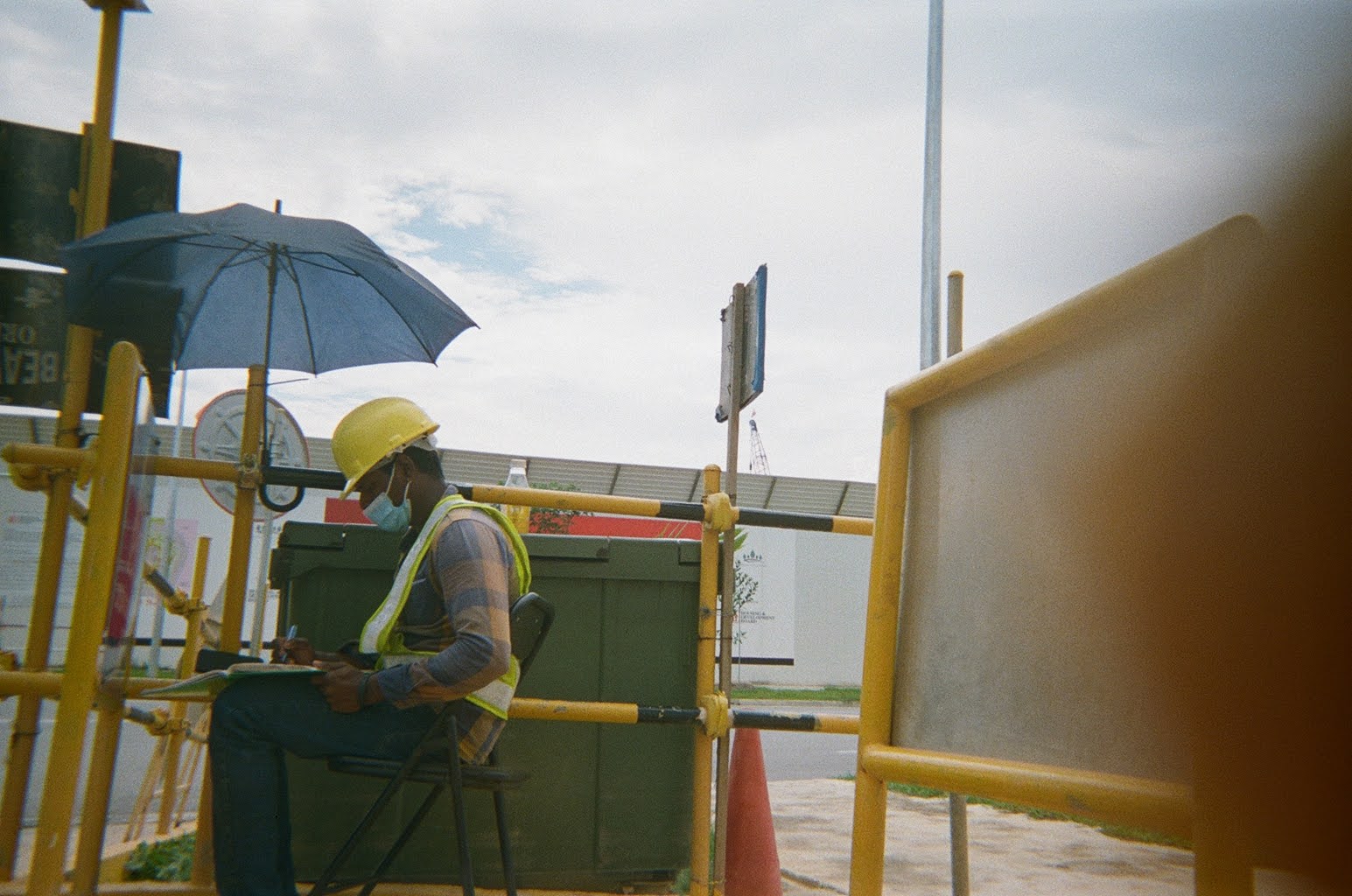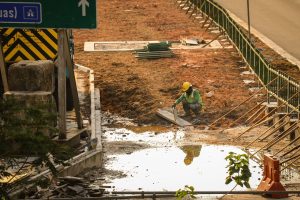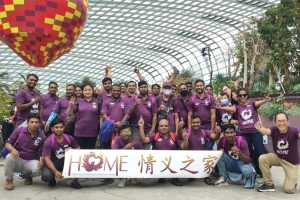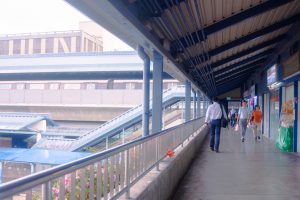It’s 5.30 am on a foggy Tuesday morning. Siva and 12 other migrant workers sit huddled at the back of a lorry, squeezed between several pieces of heavy-duty machinery and long metal pipes. With 45 minutes to go, Siva leans back—if he’s lucky, he might snag a spot in front of the vehicle’s wall—his hands grasping the side railing as he sneaks in a few more minutes of rest before another long workday ahead.
A new colleague, Abhik, unaccustomed to this mode of transportation, eyes the machinery cautiously, afraid it will fall on him. He had heard horror stories and read news of friends being injured during sudden breaks or swerves and had picked the furthest spot possible away from the danger.
Suddenly, the lorry swerves and lets out a loud horn. Abhik lets out an audible yelp, jolting several others awake, their hands instinctively clutching the railings—and life—a little tighter. Everyone’s on alert now as an unnerving silence falls on the motley crew of 13. There’s going to be no more rest today until everyone reaches the worksite. At 6.15 am, Abhik, Siva, and the rest arrive at the worksite, a tad tired but relieved that they’re still alive.
Lorries are common modes of transportation in metropolitan Singapore for migrant workers. Often they are herded at the back of these vehicles sans seat belts or other safety precautions to protect them in the event of a collision.
These ever-present threats of near misses—or actual accidents—have unfortunately become part and parcel of daily life for many migrant workers here in Singapore, building flats, MRT stations, and roads for the convenience of its citizens.

Current situation
On 20 April 2020, a lorry ferrying migrant construction workers crashed into a stationary tipper truck along the Pan Island Expressway (PIE). Two workers died, and 15 were injured. A few days later, another accident between a police van and a lorry ferrying 11 workers resulted in minor injuries for 17 people.
The prevalence of such incidents highlight that more must be done to improve the safety of migrant workers and address the flaws in the system that allow the continued use of inappropriate and unsafe transport for migrant workers.
Rubel, a migrant worker who has been working in Singapore for 10 years, told Channel News Asia that rides on the back of lorries are often uncomfortable and workers would get jostled around whenever the lorries swerved. When it rained, he would get drenched.
“There was no shelter, (and) even if there was shelter (it was) not able to stop the raining coming in,” Rubel shared.”
In conversations with migrant workers, many told of frequent minor injuries incurred en route to worksites—scrapes from the equipment being transported with them and occasional bruising from sudden stops or ‘near misses’.
Another migrant brother shared: “We need a standard and safe transportation system. We want to keep ourselves safe and well to build your country every day”.
However, the issue goes beyond what “someone who is building the country” deserves—that would suggest a higher bar than what is deemed humane. It’s not something ordinary Singaporeans need entertain as we go about our daily lives on air-conditioned trains, buses or private car hire; transportation that arrives on time, replete with smiling service providers wishing us well as we go about our day.
There is anecdotal evidence from Singaporeans who have sat in the back of lorries, proving that it’s possible to hold on to railings for support during sudden brakes. However, these experiments do not consider the fact that migrant workers are often travelling to worksites for extended periods, which means they’re usually resting or sleeping while at the back of these vehicles.
Lowered guard during rest renders them unable to react quickly, further increasing the chances of injury. That aside, no one expects ordinary commuters to be fully alert and constantly braced for impact, so there is no reason to subject migrant workers to this additional stress either.
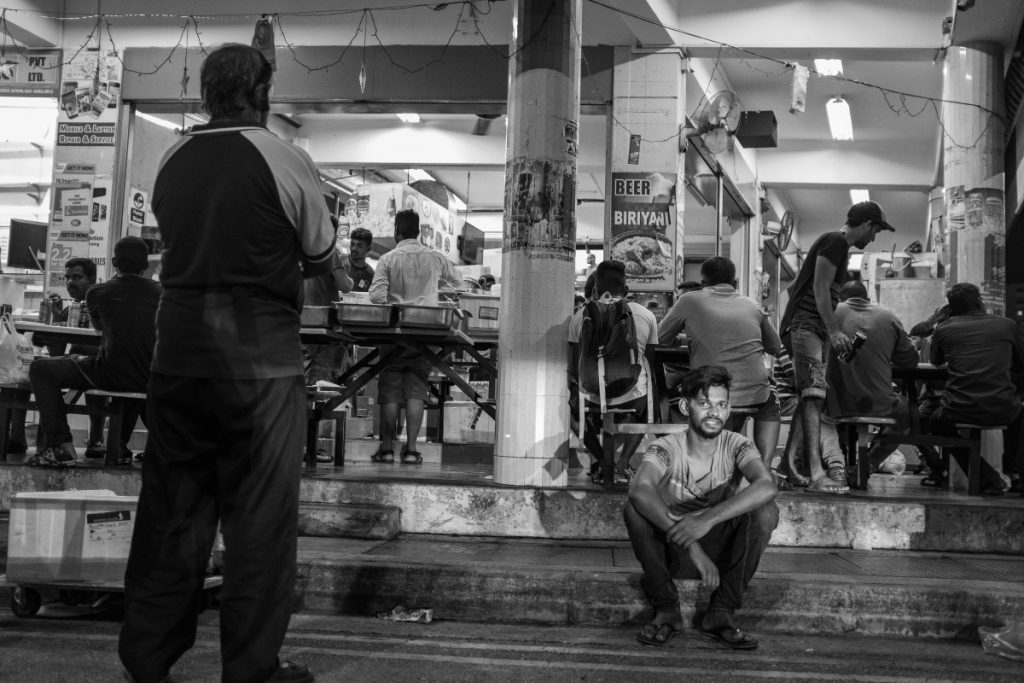
Parliament’s past & present reactions
This is not the first time that calls have been made for migrant workers to be transported in vehicles, such as buses, designed for ferrying humans.
After three foreign workers died in an expressway accident on 22 June in 2010, measures were introduced to fit lorries with canopies and higher railings and double the minimum deck space requirement. Yet, even then, talk of transporting workers in buses was dismissed as unnecessary unless these measures were deemed ineffective.
Currently, the efficacy of current measures is being substantiated with statistics showing that, over the last decade, the number of people on-board lorries who were injured or killed in road traffic accidents has been on a downward trend. Yet, a downward trend is not zero.
As aptly put by a migrant worker, “500 in 2018, 416 in 2019 and 227 in 2020 people injured doesn’t mean that [transport issues] should not be on the priority list”. Furthermore, just these numbers alone are unable to quantify the multifaceted issues that involve not only their personal well-being but also the financial and emotional losses that their loved ones will face.
The deaths and injuries that happened even after the implementation of current measures should be a testament to how they are not comprehensive enough to protect lives.
An even more compelling argument for the failure of current measures is the recent accidents in 2021. These accidents led MPs Mr Alex Yam, Ms Janet Ang, Mr Murali Pillai, Mr Dennis Tan and Ms He Ting Ru to raise questions that were eerily similar to those raised more than ten years ago, showing how little has truly changed with the safety measures.
Indeed, SMS Dr. Amy Khor herself admitted that “[f]rom a road safety perspective, it would be ideal for lorries not to carry any passengers in their rear decks”.
During WIMBY’s interviews with migrant workers, many of them also shared their belief that workers should be transported in buses and not lorries.
One migrant worker summarised this sentiment simply: “Nobody in this first world country deserves to be seated at [the] back of the lorry to get to work, or get back home”.
The recent accidents in April and May 2021 have sufficiently demonstrated that the additional measures introduced since 2011 have been insufficient in improving worker safety, and more needs to be done.

Business costs vs human life
Given that buses are the safer option to transport migrant workers, why do migrant workers continue to be transported on lorries?
SMS Dr Amy Khor cited “very significant practical and operational issues—on top of just cost considerations” in her speech. Most of the concerns she mentioned were, nonetheless, still centred around cost or are not sufficiently addressed even in the existing state of affairs.
For instance, Dr Khor shared that proposals to use vans with smaller capacities or lower the cap on deck capacity were rejected. There were concerns that more trips would be needed to ferry workers from one site to another, resulting in driver fatigue, thus compromising road safety.
Understanding the driver role
Yet, implementing fines on lorry drivers who fail to comply with safety measures seems counterproductive, pushing the blame of compromised road safety to the migrant workers who function as drivers.
In interviews WIMBY held with migrant workers, many of them said that most lorry drivers are migrant workers who drive on top of their primary job. Coupled with the fact that there is often neither rest time between each driving job nor a restriction on the number of hours driving, drivers are frequently exhausted.
Drivers also operate under high stress. Not only do they not get additional pay from driving, but they also risk having their pay docked if they are late. They are also made to foot the bill if they choose ERP routes over non-ERP routes.
Migrant workers should not only be prevented from further fatigue by discouraging more trips for drivers, the drivers’ current stressors and causes of fatigue should also be taken into consideration and addressed to reduce current fatigue.
Our interviews with migrant workers revealed that there are many other root causes of driver fatigue, including the lack of restrictions on the number of driving hours, mandated breaks between driving jobs, and the stressful environment that drivers generally have to operate in. They also have to manage multiple controllers providing conflicting instructions and the ever-present fear of their pay being docked with the slightest delay.
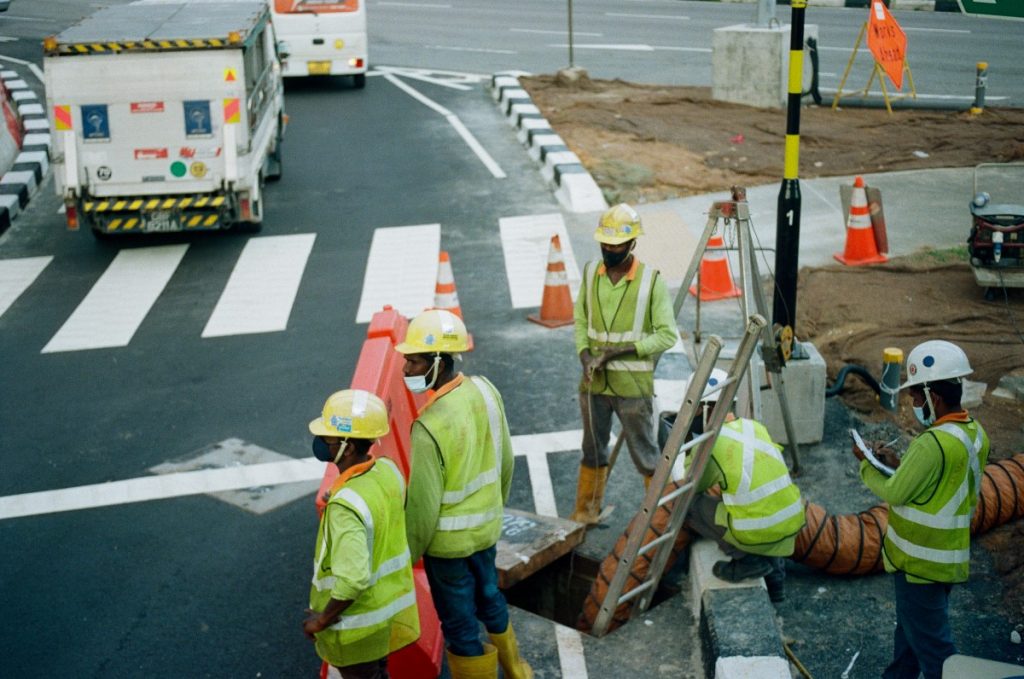
What more can be done?
Besides ensuring sufficient rest, more can be done to implement change in the driver role, such as ensuring that driving is a sole, specialised role assigned to a specific migrant worker, rather than a role filled on an ad-hoc basis by a rotation of migrant workers.
Rest time could also be instituted between driving jobs or a mandatory limit imposed on daily driving hours.
Still, above all else, the priority should be to invest in safe transport vehicles.
At the heart of this issue lies the tradeoff between cost and worker safety. Even the operational consideration raised by Dr Khor that using buses would result in significant productivity loss as “lorries can have dual use for transporting workers and equipment [but] buses cannot” arguably boils down to cost.
This focus on ‘productivity loss’ is one shared across the sector, with migrant workers having been discouraged from making double trips for years and many instances of lorries being overloaded to save time and money.
In her speech, Dr Khor shared that industry associations provided feedback about the significant rise in business costs that would result in the switch to dedicated bus transport, a sentiment that was echoed by employers interviewed by The Straits Times.
These considerations about cost have been exacerbated by the COVID-19 pandemic. For example, the construction sector, a major employer of migrant workers in Singapore, shrank by 46.22% and 28.5% on a year-on-year basis during the third and fourth quarter of 2020 respectively.
There is no question that it will cost more to improve worker safety, but ethically, cost considerations should never be a de facto trump against worker safety.
Instead, we hope that employers and the relevant authorities can conduct a detailed study of mitigating the additional costs incurred from transporting workers in buses and that employers and the relevant authorities can seriously commit to such measures over time.
As MP for Radin Mas and Assistant Sec-Gen of NTUC Melvin Yong pointed out, local companies such as Woh Hup (Private) Ltd. and Siong Yu Seng Construction Pte Ltd. already transport all their workers in buses. Challenges surrounding cost and operations are not always insurmountable, as popularly believed.
In any situation, it is difficult to justify how the safety of humans can be compromised for the sake of money. Numbers are unable to quantify the sanctity of human life: one life lost is one too many.
When WIMBY asked some migrant workers how they felt about the responses by employers and the ministry, they mentioned that they “didn’t feel good after reading the articles. It looks like migrant brothers’ [lives] [are] too cheap to push the policy to change”. As a society, we must recognise that migrant workers are equals and not merely factors of production or a mean to an end.
Many migrant workers have sacrificed much to earn a better living for their families back home. In the words of WIMBY’s migrant friend, “Everybody [has] a family to feed back home and most importantly, nobody came here to die.”
When the safety of these workers is so vastly compromised, it is not just the workers’ personal lives and livelihoods at stake but also their loved ones’ financial and emotional losses.
Migrant workers often carry out labour that is lowly paid and associated with a lower “status”, but this should never be a reason for us to dismiss and dehumanise them. Many of us may forget that these workers are human, but they deserve just as much respect and compassion as the rest of us.
We must fight for the fundamental rights of these migrant workers and recognise that they are, in fact, the cornerstones of our society. In a migrant worker’s own words, “Please. Our lives matter—add some value into it.”

